Scotland's Islands & Highlands Tour Diary
Day 7 : Loch Ness and Fort
Augustus
|
|
One of Scotland's best known icons and most popular
attractions - ruined Urquhart Castle on the shores of Loch
Ness |
Back via two ferries to the
mainland again today, then touring alongside and spending
time at Loch Ness, but no sign of any monsters.
Part
of an 11 day/page trip diary - click the links on the right
hand side for the other days in this diary. |
Jeanette and her husband Ken
were on our 2010 Scotland's Islands and Highlands Tour, and
Jeanette kept a detailed day by day diary of the tour.
She has very graciously allowed
it to be re-published here, so as to allow you an unvarnished
view into what the tour was all about.
The text is hers, which I've
respected and not changed apart from a few subheadings and extra paragraph
breaks and some Americanizations of her English spelling (they
are from New Zealand).
I've sourced the pictures and
their captions are also from me, not Jeanette.
You can follow along with her
narration by tracking the tour on this
tour
itinerary page and the linked Google maps.
I hope this will encourage you
to come on our
2011 Scotland's Islands and Highlands Tour.
Day 7 – Sunday June 20th
2010 – Fort Augustus and Loch Ness
Google Touring Map for the Day
It was Father's Day in
Scotland.
I was woken with the alarm
at 6:45am but Ken was already up and getting ready for the day.
We had to be on the coach with our bags by 8:15am. No time for a
hot breakfast as it only starts at 8am but they laid out muesli
etc and fruit and toast so we managed to get some sustenance
before Jay drove off at 8:11am (4 minutes early). We had a 30
minute drive then a 15 minute ferry from Fishnish to Lochaline,
on the mainland.
We arrived at the ferry at
8:40am and had time to stretch our legs for a while before the
ferry arrived. There are no bookings for this ferry so David was
determined to be early to ensure we got in line before too many
others. The breeze was fairly light but very chilly so we all
returned to the warmth of the bus in plenty of time. The ferry
arrived at 9am and sailed on time at 9:10am. We turned the GPS
on and enjoyed watching the ship crossing the loch at 10mph.
There were only 3 cars, a caravan, a motorhome and our bus so
there was plenty of room.
|
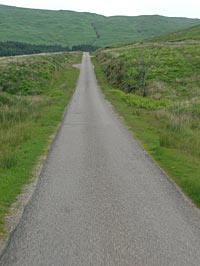
One of the many one lane roads our coach drove us
along - you can just make out regular passing bays in the
distance ahead. At least this part of the road was
straight. |
Once on the mainland we had
to drive north to Ardgour to get the next ferry across Loch
Linnhe to Corran. Even though this was an A road it once again
was a single track with frequent passing bays. It was hilly
country so the road went up and down a lot. The sky is a lot
cloudier today and the air is quite cool. We saw a couple of
deer close by the road, watching us pass by. We drove down to
one loch where we saw a group of kayakers having a rest on the
bank and happily waving to us. At the end of the loch we turned
onto a normal 2 lane road so we could travel much faster,
although still well below the speed limit of 60mph, and over a
number of cattle stops.
While traveling along Loch
Linnhe we could see the 4,406 ft (1,343 m) high Ben Nevis, the
highest mountain in Great Britain. There were no clouds over the
mountain so we could see the top, which is fairly unusual. It
was a very pretty drive with thousands of purple Rhododendron
bushes along the loch in full flower. We arrived in Ardgour at
10:16am in good time for our next ferry ride at 10:30am. This
was just a 5 minute crossing to Corran, once we were onboard
with about 12 cars, 2 motorbikes and the motorhome and caravan
we had met on the previous ferry.
We drove North and passed
through Fort William about 10:52am. This was the first town in
Scotland to get street lighting. Ken was time keeper for David
to get the time needed to return to Fort William tomorrow to
catch the train. The water from Loch Laggan comes through the
hills in tunnels then down the hillside in a series of long
pipes (15 miles) to the power station in Fort William. We drove
on past the White Corries which is Scotland's main ski fields.
There is even enough snow for them to be able to ski/snowboard
tomorrow, Mid Summer's day, June 21st.
On our way up the Great
Glen, we stopped at Spean Bridge at 11:05am for a 20 minute
stop, in our driver Jay's home town. It was a very comfortable
stop with plenty of room for the many buses stopping there.
There was a very extensive shop with lots of Scottish clothing.
Ken saw a model in full highland dress and decided he wanted to
get a pair of 'flashes', which are fancy garters, to use when he
is wearing long socks with dress shorts. Unfortunately they were
out of stock.
|
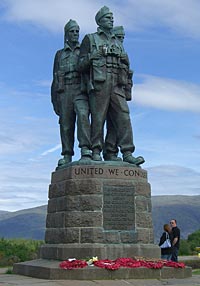
The Commando Memorial, close to Spean Bridge. |
Our next stop was a mile up the road at the Commando Memorial
commemorating all the commandos lost in World War II. They all
trained in the hills only 8 miles north of Spean Bridge. The
memorial had 3 larger than life size men standing on a high
plinth. They were models of actual commandos but no names were
made public. It was most impressive and we had great views over
the high hills around us.
At 11:45am we were underway
again driving up a narrow valley towards Loch Ness, We drove
beside the Caledonian Canal which joins the west coast at
Corpach near Fort William to the east coast at Inverness through
4 Lochs (lakes), Loch Lochy, Loch Oich, Loch Ness and Loch
Dochfour. The lochs are part of the Great Glen, a geological
fault in the earth's crust. The total distance is 60 miles
(96.5km) of which the man-made canal joining the lochs is 22
miles (35.5km) long.
Thomas Telford designed and
built the canal. He also designed the Pontcysyllte Aqueduct on
the Llangollen Canal, the Menai Straits Bridge in Wales and the
Gota Canal in Sweden. The construction was commenced in 1803 and
was finished 19 years later in 1822 with an initial depth of 15
feet (4.6 m). This was increased to 18 feet (5.5 m) when repairs
were carried out in 1847. The canal has 29 locks, 4 aqueducts
and 10 bridges. It was conceived as a way of providing
much-needed employment to the Highland region. The area was
depressed as a result of the Highland Clearances, which had
deprived many of their homes and jobs. They were faced with laws
which sought to eradicate their culture, including the right to
wear tartan, to play bagpipes, and to speak Gaelic, so many were
emigrating to Canada or to the Scottish lowlands.
In the meantime,
shipbuilding had advanced, with the introduction of
steam-powered iron-hulled ships, many of which were now too big
to use the canal. The navy did not need to use the canal either,
as Napoleon had been defeated at Waterloo in 1815, and the
perceived threat to shipping when the canal was started was now
gone. Commercially, the venture was not a success, but the
dramatic scenery through which it passes led to it becoming a
tourist attraction. Queen Victoria took a trip along it in 1873,
and the publicity surrounding the trip resulted in a large
increase in people visiting the region and wanting to travel on
the canal. Even the arrival of the railway at Fort William, Fort
Augustus and Inverness did little to harm the canal, as trains
were scheduled to connect with steamboat services. There is a 73
mile (117km) long-distance footpath called the Great Glen Way
from Fort William to Inverness which follows the canal and the
lochs.
|
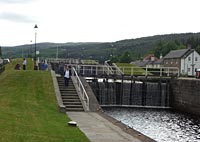
The staircase locks at Fort Augustus. |
It was much sunnier in the
afternoon with no rain all day. We passed through Fort Augustus
at 12:12pm where we will be staying for the night at the Lovat
Arms hotel, right near a flight of 4 locks on the canal. We
drove north along the foreshore of Loch Ness (755 feet/230m deep
with more fresh water than the rest of the lakes in England and
Wales) to Urquhart Castle. The ruins were very impressive,
standing on a commanding position overlooking the loch. St
Columba visited this area around AD 580 on his way to meet with
the King of the Picts in Inverness.
It is not known precisely
when the castle was built, but records show the existence of a
castle on this site from the early 13th century. The area had
been granted to the Durward family in 1229, and they are thought
to be the builders of the castle. From the 13th century, until
its demise in 1692, Urquhart saw much military action. In 1296
it was captured by Edward I of England, known as the ‘Hammer of
the Scots’. Thereafter, the stronghold passed back and forth
between Scottish and English control. In the 14th century, it
figured prominently in the Scots’ struggle for independence and
came under the control of Robert the Bruce after he became King
of Scots. In 1332, in the dark days following King Robert
Bruce’s death, Urquhart remained the only Highland castle
holding out against the English. Soon after the English threat
evaporated the MacDonalds, Lords of the Isles arrived. Time and
again, they swept through Glen Urquhart in their quest for more
power. The castle passed back and forth between the Crown and
the Lords of the Isles like a bone between two dogs. Their last
raid, in 1545, proved the worst for the Crown. The Isles men got
away with an enormous hoard, including 20 guns and three great
boats.
|
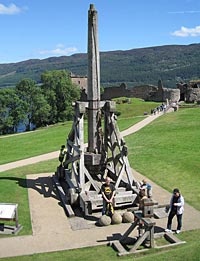
The trebuchet at Urquhart Castle, with the castle
ruins in the background. |
In the twilight of its days
as a seat of the chief of Clan Grant, Urquhart continued to
prove its worth. It was last garrisoned in 1692, and legend
claims that the towering gatehouse was blown up so that the
castle could never again be a military stronghold for the
Jacobites. Over a thousand years of stirring history were buried
beneath the rubble. The castle soon fell into decay. Part of the
Grant Tower crashed to the ground in 1715 during a violent
storm. But attitudes changed, and during the 19th century the
ancient stronghold came to be viewed as a noble ruin in a
majestic setting. It passed into state care in 1913, and is now
one of the most visited of all Scotland’s castles.
We started our tour at
12:40pm watching a short 8 minute film of its history before
walking down the hill to the ruins, right on the edge of the
loch. We passed a trebuchet (siege engine/giant catapult) which
was brought here by King Edward I. Test firings show it can
throw a 11kg (24lbs) stone ball 140m (459 feet) with accuracy.
The largest trebuchet ever built, with a 20 ton counterweight,
could throw the same stone ball 400m (.25 mile). We enjoyed the
walk around the site and climbed the great tower for superb
views over the loch and the castle ruins. We bought 4 books for
£12.43 - “The Highland Clearances”, “Scottish History”,
“Culloden 1746” and “Urquhart Castle”.
|
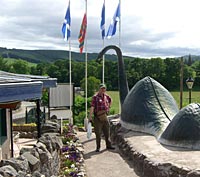
David and a model Loch Ness monster outside the
Original Loch Ness Visitor's Center, which David prefers to
the other one located almost immediately adjacent, also in
Drumnadrochit. |
At 2:30pm we drove to the
Original Loch Ness Visitor's Centre, not the new modern centre.
We were shown a 28 minute movie about Loch Ness and its monster
which was interesting but much longer than it needed to be as
there was a lot of 'filler' video of the lake showing nothing
unusual.
We looked around the shop for a short while, took some
photos with a mock-up of the monster then we were all back on
the bus by 3:30pm for our journey back to Fort Augustus and the Lovat Arms hotel.
Our room 35 was a spacious
room and bathroom in a separate motel like building in the
grounds of the hotel. We hoped it would not be raining in the
morning or we would be getting rather wet getting to breakfast.
We turned on the TV to see what channels we had as there was a
sky box under the TV. We found the NZ vs Italy World Cup match
in progress into the 2nd half so we watched that to its finish.
The final score was an amazing 1-1 so NZ did very well against a
previous world champion side. We then went for a walk down to
the flight of locks and just missed seeing a group of boats
passing through the bottom lock. The swing bridge was just
closing as we arrived. We walked up the steps beside the 5 locks
to see if any other boats would be coming down but the notice
said the next traverse of the locks would be at 8:10am in the
morning.
We went back to the hotel to
shower and get ready for dinner at 7pm in the hotel dining room.
I started with fresh local mussels in a white wine, garlic and
cream sauce while Ken had hot whisky smoked duck slices. For our
main course I had smoked salmon fillet with prawns and a salad
while Ken had local rack of lamb with asparagus and carrots. We
also had a side dish of broccoli and almonds, all helped down
with a nice glass of Magners Cider. After dinner we took another
walk down to the canal and visited a shop called 'The Clanmans
Centre', which was still open at 9pm. It was full of things
Scottish and was most interesting.
On returning to our room we
collected our laptops and went into the lounge to get wifi
internet access. We downloaded all 88 photos from Ken's camera
and 395 photos from my camera. I had to adjust the time on all
the photos as both cameras were an hour ahead, still on Germany
time from our recent German/Austrian tour.
About 11pm (10am in
NZ) I rang Mum and caught up with all the decisions she had been
making for her newly renovated home while I had been out of
touch. We talked for about 25 minutes then it was time to go
back to our room for a hot chocolate drink. Many thanks to Ieva,
next door, for the extra hot chocolate sachets. We swapped our
coffee for her hot chocolate. I had quite a problem cough
tonight and a headache so I hope I feel better tomorrow. Lights
out about 12:30am.
Read more in the rest of
Jeanette's Diary
See the links to each day
of the eleven day tour/trip diary at the top
right of this page.
|
If so, please donate to keep the website free and fund the addition of more articles like this. Any help is most appreciated - simply click below to securely send a contribution through a credit card and Paypal.
|
Originally published
7 Jan 2011, last update
30 May 2021
You may freely reproduce or distribute this article for noncommercial purposes as long as you give credit to me as original writer.
|

